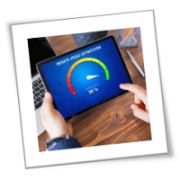For many of today’s website operators, boosting conversion rates is one of the primary goals. Transforming casual visitors into loyal customers is, after all, the ultimate aim of maintaining an online presence. To facilitate this crucial mission, we present these five practical tips you can immediately implement to boost your site’s conversion rate.
Keep it simple
Emphasizing simplicity is crucial in web design. Unnecessary elements can be confusing and time-consuming for users to navigate. Each page, word, and image on a company website should actively contribute to the goal of prompting visitors to contact you, so steer clear of excess information, irrelevant games, and distracting animations. Opt instead for a clean layout that enables visitors to immediately understand what you’re offering and how they can connect with you with a single click.
Mobile matters: Prioritize the phone view
Your website needs to work flawlessly on smartphones. That’s where many people are browsing, and if your site gives them trouble, they’ll bounce faster than a rogue email.
Mobile-first design tackles this head-on. It means building your website with mobile users in mind first, then expanding it for larger screens. Think responsive layouts that automatically adjust, buttons designed for thumbs, and easy navigation — not just on the home page, but everywhere. You can think of it as being similar to a map: every corner should be reachable without users getting lost.
Enhance your site with engaging photos
They say a picture speaks a thousand words, and in website design, this rings particularly true. The right image can instantly capture visitors’ attention, making your site more memorable.
When choosing photos for your website, opt for high-quality, relevant images. Avoid using generic stock photos whenever possible. Instead, showcase your team and offerings with original images. With original photos, you have control over the message they convey, helping you stand out from the competition.
Consistency is key to connecting with your audience. Use a specific photographic or graphic style that your audience can easily identify. This not only contributes to your brand’s trustworthiness but also makes it more relatable.
Improve social media icon placement
Adding social media icons can boost your business’s credibility, but it comes with a caveat. Placing these icons at the top of a page may tempt visitors to click away, leading them to get sidetracked on social media. Remember, the main goal is to keep visitors on your website, exploring what you have to offer.
To achieve this, consider relocating the social media icons to the bottom of the page or in the footer area. This move ensures that visitors engage with your services and content first before venturing into the social media sphere.
Make it easy to connect — don’t hide your contact info
Need help from your website visitors? Don’t bury your contact details. Put your phone number, email address, or even live chat options front and center. Make it easy for site visitors to reach you, whether they’re just curious or ready to buy.
This is especially helpful for people who might not want to leave their email on a form. Give them a direct way to connect, and you’ll open the door to more conversations and conversions.
Turning your website into a conversion machine doesn’t require fancy tricks. By focusing on the basics — clear information, easy navigation, and simplicity — you make it easy for potential customers to get in touch.
Boosting conversions on your website is all about the basics. Follow these tips, focus on key website elements such as clear info and easy navigation, and you’ll create a space that both looks good and turns visitors into customers. If you need more website tips and/or other assistance with anything IT-related, contact us today.
If you are looking for an expert to help you find the best solutions for your business talk to GCInfotech about a free technology assessment
Published with consideration from TechAdvisory.org SOURCE




